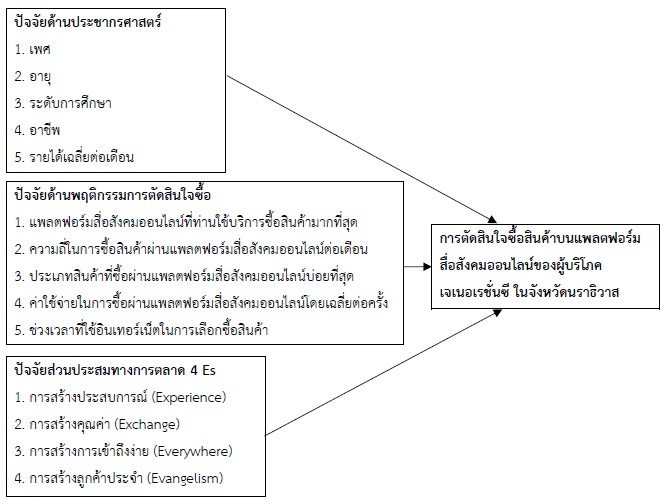Factors Influencing the Decision to Purchase Products on Social Media Platforms among Generation Z Consumers in Narathiwat Province
Main Article Content
Abstract
This research aimed to 1) study demographic factors and purchasing behavior of Generation Z consumers in Narathiwat province and 2) examine marketing mix factors influencing purchasing decisions on social media platforms among Generation Z consumers in Narathiwat province. This quantitative research used systematic random sampling to collect data from 400 Generation Z consumers through questionnaires. Statistical analysis employed frequency, percentage, standard deviation, Pearson Correlation Coefficient, and Multiple Regression Statistics.
The findings revealed that most respondents were female undergraduate students or graduates with an income below 5,000 baht. They preferred shopping on TikTok, particularly for cosmetics and beauty products, typically making purchases during nighttime with spending under 500 baht per transaction. The regression analysis showed that the 4Es marketing mix factors significantly influenced consumer purchasing decisions at a high level (R² = 72.63%). Experience had the strongest influence (Beta = 0.403), followed by Evangelism (Beta = 0.235), Everywhere (Beta = 0.188), and Exchange (Beta = 0.103). These results indicate that consumers prioritize ease of product search, order tracking systems, and promotions. The study suggests that marketing strategies focusing on experience and accessibility are crucial factors in Generation Z purchasing decisions. Businesses should concentrate on developing user-friendly platforms, creating positive experiences, and implementing marketing strategies aligned with target audience behavior.
Article Details
References
กรมธุรกิจการค้า. (2564). รายงานประจำปี 2564 กรมพัฒนาธุรกิจการค้า กระทรวงพาณิชย์. https://drmlib.parliament.go.th/site.php mod=document&op=checkout
ชนิดา พุ่มนิคม. (2564). พฤติกรรมการบริโภคและความอ่อนไหวด้านราคาของผู้บริโภคเจนเนอเรชั่นซีในพื้นที่ภาคใต้. วารสารบริหารธุรกิจและการจัดการ, 10(2), 45-62.
ฉัตยาพร เสมอใจ. (2550). พฤติกรรมผู้บริโภค. ซีเอ็ดยูเคชั่น.
โชติมา วัฒนะ. (2561). เครือข่ายสังคมออนไลน์-ประโยชน์และโทษ. วารสารรังสิตสารสนเทศ, 24(1), 127-140.
ณัฐพล ม่วงทำ. (2565). อิทธิพลของสื่อสังคมออนไลน์ต่อกระบวนการตัดสินใจซื้อสินค้าของผู้บริโภคเจเนอเรชั่นซีในประเทศไทย. วารสารบริหารธุรกิจ มหาวิทยาลัยธรรมศาสตร์, 45(174), 34-52.
ทศพล ปรีชาศิลป์ และพัทธ์พสุตม์ สาธุนุวัฒน์. (2565). อิทธิพลของสื่อสังคมออนไลน์ต่อการตัดสินใจซื้ออสังหาริมทรัพย์. วารสารวิทยาการจัดการปริทัศน์, 24(3), 251-262.
ไทยรัฐออนไลน์. (2566, 11 พฤษภาคม). เปิดพฤติกรรม GenZ ผู้ขับเคลื่อนตลาดออนไลน์. https://www.thairath.co.th/lifestyle/life/2693000
ธนาภา หิมารัตน์. (2559). ปัจจัยที่ส่งผลต่อการยอมรับเทคโนโลยีทางการเงิน บริบทธนาคารพาณิชย์ [วิทยานิพนธ์ปริญญามหาบัณฑิต]. มหาวิทยาลัยธรรมศาสตร์.
ธนาคารกรุงศรีอยุธยา จำกัด (มหาชน). (2567). แนวโน้มธุรกิจและอุตสาหกรรมไทยปี 2566-2568. https://www.krungsri.com/th/research/industry/summary-outlook/industry-outlook-20 23-2025
ไปรยา อรรคนิตย์. (2561). ปัจจัยที่มีผลต่อการส่งต่อ (Share) วิดีโอคอนเทนต์ออนไลน์ผ่านทางสื่อ Social Media (โซเชียลมีเดีย) ของวัยรุ่น Gen Z [การค้นคว้าอิสระปริญญามหาบัณฑิต]. มหาวิทยาลัยกรุงเทพ.
พรพรรณ ตาลประเสริฐ. (2559). อิทธิพลของการตลาดแบบดิจิทัลต่อการตัดสินใจซื้อของผู้บริโภคกลุ่มธุรกิจการพาณิชย์อิเล็กทรอนิกส์ในเขตจังหวัดกรุงเทพมหานคร [การค้นคว้าอิสระปริญญามหาบัณฑิต]. มหาวิทยาลัยกรุงเทพ.
พรพรรณ ตาลประเสริฐ. (2565). ความสัมพันธ์ระหว่างส่วนประสมทางการตลาด 4E กับพฤติกรรมการซื้อสินค้าออนไลน์ของกลุ่มเจเนอเรชั่นซี. วารสารการจัดการสมัยใหม่, 20(1), 78-90.
ระบบสารสนเทศกรมสนับสนุนด้านการส่งเสริมสุขภาพและอนามัยสิ่งแวดล้อม. (2567). รายงานข้อมูลจังหวัดนราธิวาส. https://3doctor.hss.moph.go.th/main/rp_ampur?region=12&prov=OTY=&pro vn=4LiZ4Lij4Liy4LiY4Li04Lin4Liy4Liq
รัตติยา บัวสอน. (2566). การสร้างประสบการณ์ลูกค้าผ่านเนื้อหาเชิงโต้ตอบบนสื่อสังคมออนไลน์: กรณีศึกษาแบรนด์ที่ได้รับความนิยมในกลุ่มเจเนอเรชั่นซี. วารสารการสื่อสารการตลาดดิจิทัล, 8(3), 112-129.
วิทยา ด่านธำรงกูล. (2566). กลยุทธ์การสร้างความภักดีและการสนับสนุนแบรนด์ผ่านสื่อสังคมออนไลน์ในยุคดิจิทัล. วารสารบริหารธุรกิจ, 46(2), 56-75.
สำนักงานพาณิชย์จังหวัดนราธิวาส. (2668). ประชุมคณะกรรมการร่วมภาครัฐและเอกชนเพื่อพัฒนาและแก้ไขปัญหาทางเศรษฐกิจจังหวัดนราธิวาส (กรอ.จ.นราธิวาส) ครั้งที่ 3/2568. https://narathiwat.moc. go.th/th/page/item/index/id/25
สำนักบริหารการทะเบียน กรมการปกครอง. (2567). ข้อมูลพื้นฐานด้านการพัฒนาจังหวัดชายแดนใต้. http://idc.sbpac.go.th/web/dash_pp_age_dashboard.php
เสรี วงษ์มณฑา. (2542). การวิเคราะห์พฤติกรรมผู้บริโภค. ธีระฟิล์มและไซเท็กซ์.
สำนักงานพัฒนาธุรกรรมทางอิเล็กทรอนิกส์. (2566). รายงานผลการสำรวจพฤติกรรมผู้ใช้อินเทอร์เน็ตในประเทศไทย ปี 2567. กระทรวงดิจิทัลเพื่อเศรษฐกิจและสังคม.
สำนักงานพัฒนาธุรกรรมทางอิเล็กทรอนิกส์. (2566). รายงานผลการสำรวจพฤติกรรมผู้ใช้อินเทอร์เน็ตในประเทศไทย ปี 2566. กระทรวงดิจิทัลเพื่อเศรษฐกิจและสังคม.
อรรนพ เรืองกัลปวงศ์. (2565). อิทธิพลของการออกแบบแพลตฟอร์มและช่องทางการเข้าถึงต่อการตัดสินใจซื้อสินค้าออนไลน์ของผู้บริโภคกลุ่มเจเนอเรชั่นซี. วารสารเทคโนโลยีสารสนเทศ, 18(2), 42-59.
Cheung, M. L., Pires, G. D., & Rosenberger, P. J. (2021). The influence of social media influencers on purchase intention: The mediating role of trust. Journal of Business Research, 130, 322-334.
Francis, T., & Hoefel, F. (2018). ‘True Gen’: Generation Z and its implications for companies. McKinsey & Company.
Fetherstonhaugh, B. (2018). The 4Es of Marketing: The New 4Ps. Ogilvy One Worldwide.
Francis, T., & Hoefel, F. (2018). 'True Gen': Generation Z and its implications for companies. McKinsey & Company.
Fromm, J., & Read, A. (2021). Marketing to Gen Z: The rules for reaching this vast and very different generation of influencers. AMACOM.
Global Web Index. (2023). Social media trends among Generation Z consumers. GWI Annual Report.
Krittanawong, C., Johnson, K. W., Rosenson, R. S., Wang, Z., Aydar, M., & Baber, U. (2020). Artificial intelligence in digital marketing and its impact on consumer engagement. Journal of Retailing and Consumer Services, 54, 101974.
Kotler, P. (1997). Marketing management: analysis, planning, implementation and control. (5th ed.). Prentice Hall.
Kotler, P., Kartajaya, H., & Setiawan, I. (2017). Marketing 4.0: Moving from traditional to digital. John Wiley & Sons.
Kotler, P., & Keller, K. (2021). Marketing Management (15th Global ed.). Pearson Education Limited.
Nielsen, R. (2015). Global Trust in Advertising Report. Nielsen Global Survey of Trust in Advertising.
Pine, B. J., & Gilmore, J. H. (2019). The experience economy: Competing for customer time, attention, and money. Harvard Business Press.
Priporas, C. V., Stylos, N., & Fotiadis, A. K. (2017). Generation Z consumers' expectations of interactions in smart retailing: A future agenda. Computers in Human Behavior, 77, 374-381.
Statista. (2022). Generation Z purchasing behaviors on social media platforms. Statista Research Department. https://www.statista.com/statistics/1395679/online-purchase-drivers-gen-z/
Schmitt, B. (1999). Experiential Marketing. Journal of Marketing Management, 15(13), 53-67.
Sashi, C. M. (2021). Digital marketing engagement, advocacy and loyalty among Generation Z consumers. Journal of Marketing Management, 37(5), 549-577.
Turner, A. (2022). Generation Z: Technology and social interest. Journal of Individual Psychology, 71(2), 103-113.
Yamane, T. (1973). Statistics: An int Introductory analysis (3rd ed.). Harper International Edition.


